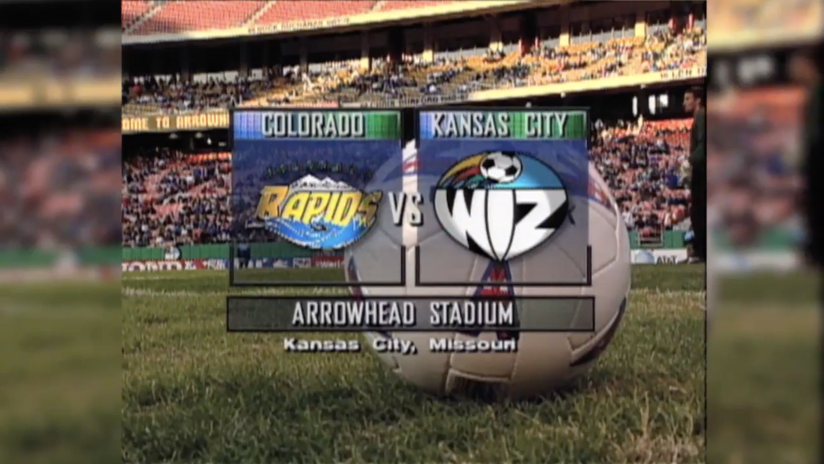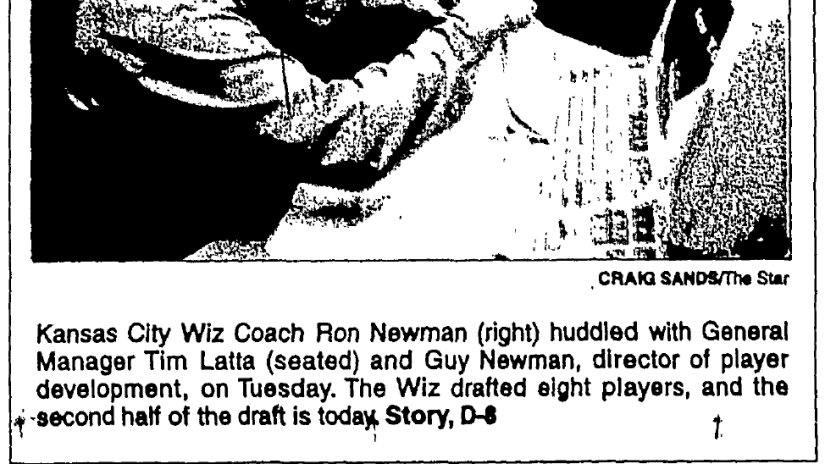
April 25, 1994
After Major League Soccer was unveiled with the goal of beginning play in April 1995, cities across the country – including Kansas City – were working to finalize bid applications by the May 15, 1994 deadline.
Among the essential components was a satisfactory stadium solution and one criteria became clear.
“MLS chairman Alan Rothenberg has repeatedly stated that all 12 franchises will play on natural grass surfaces, either immediately or as soon as possible.”
“The league requires that its teams play on natural grass.”
“MLS has no interest in playing on artificial turf.”
Arrowhead Stadium opened in 1972 with an artificial surface called Tartan Turf. The original field was replaced for the Chiefs 1985 season with AstroTurf-8.
But after 22 years, the Jackson County Sports Authority passed a resolution on Feb. 16, 1994 paving the way for natural grass to be installed for the first time at Arrowhead and, in the words from the club’s 1996 media guide, “paving the way for soccer to become a permanent resident at America’s finest stadium.”
Arrowhead was confirmed as Kansas City’s proposed MLS venue on March 29th and work began to remove the turf on April 25, 1994. The project entailed removing 9,000 tons of dirt and asphalt before installing drainage and irrigation systems, as well as telecommunications cables and electrical conduit, until finally installing the soil base, with a 12-inch crown, for Bermuda sod.
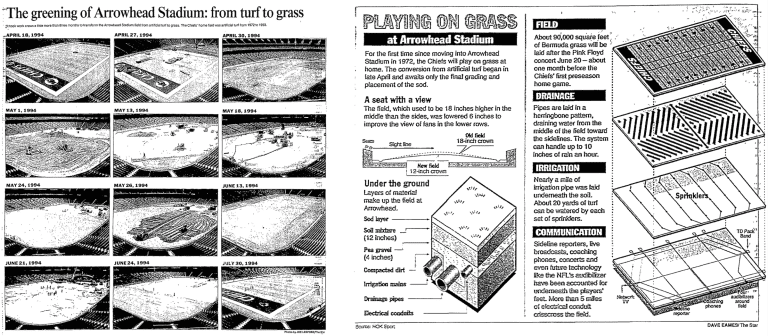
All was done in time for the Chiefs preseason opener on July 31 – as part of a rare football-baseball doubleheader at Truman Sports Complex that last happened during the 1985 World Series – and Kansas City wasn’t shy about promoting the new field in its marketing efforts.

June 15, 1994
Today is decision day for Major League Soccer.
Newspapers in cities from coast to coast prepped readers for Major League Soccer’s highly-anticipated news conference from Soldier Field in Chicago.
The league’s May 15 deadline for potential MLS markets to submit applications had produced 22 bids…
Atlanta, Boston, Columbus, Dallas, Denver, Detroit, Houston, Indianapolis, Kansas City, New York, Los Angeles, Louisville, New Jersey, Pittsburgh, Phoenix, Raleigh-Durham/Winston-Salem, Sacramento, San Jose, Seattle, Tampa Bay, Tulsa, Washington, D.C.
…and the league was now poised to reveal the 12 cities from the field that would be awarded Major League Soccer franchises.
Except, only seven were announced – one of which failed to come to fruition.
- Boston
- Columbus
- New York (Long Island)
- Los Angeles
- New Jersey
- San Jose
- Washington, D.C.
Four cities – Louisville, Pittsburgh, Phoenix and Raleigh-Durham/Winston-Salem – were no longer in consideration, which at the time left Kansas City and 10 other bidders competing for one of the final five franchises.
"Kansas City put together an excellent bid," Rothenberg said. "Overall, it was as fine of an effort as it could have been."
Rothenberg indicated the remaining selections would be decided by Aug. 1 as attention shifted to the 1994 FIFA World Cup from June 17-July 17 in nine cities across the United States.
“Kansas City will have to wait a little longer to see whether it will be awarded a professional outdoor soccer franchise,” the KC Star wrote on June 16.
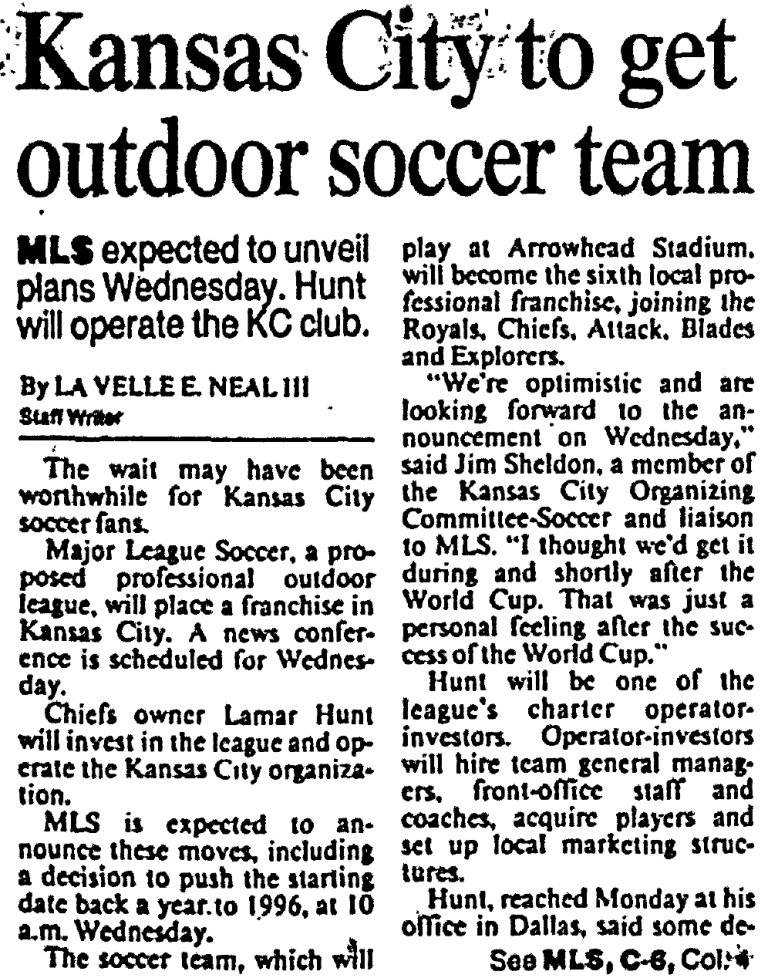
Or so they thought. Five months later...
Nov. 16, 1994
Kansas City to get outdoor soccer team
That was the headline on the front page of the Kansas City Star sports section ahead of a scheduled press conference by Major League Soccer in New York on Nov. 16, 1994.
After Kansas City’s entry to Major League Soccer had been put on hold at the last MLS announcement, local leaders were poised to celebrate the long-awaited coronation.
“We’re optimistic and are looking forward to the announcement,” said Jim Sheldon, a member of the Kansas City Organizing Committee.
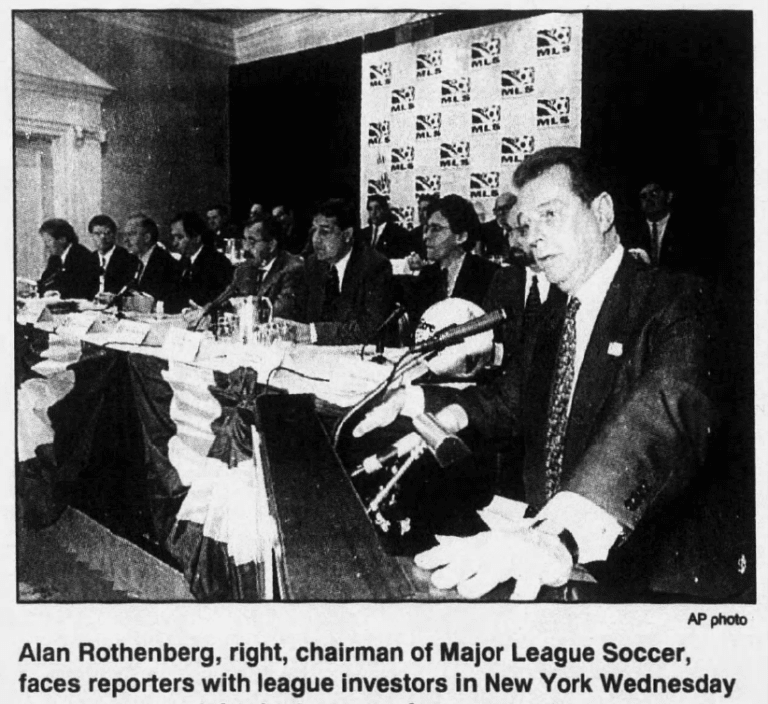
As expected, Major League Soccer did announce it was awarding teams to new cities.
Just not Kansas City.
Rothenberg congratulated Tampa Bay and Chicago, which didn’t originally submit a bid and would ultimately be replaced six months later, among several other pieces of news.
MLS was delaying its inaugural season until April 1996
“From the beginning, we have all said that it is far more important that we launch Major League Soccer right than do it on any particular, preordained timetable,” Rothenberg said. “We are not going to be rushed into doing anything that we will regret later.”
Long Island’s team would not be part of the inaugural season as initially announced
“A new stadium was planned and we will definitely have a team there when the stadium is ready, hopefully in 1997,” Rothenberg said.
MLS would begin with 10 teams if insufficient funding was secured for 12 teams
Miami and San Diego were also added to the mix of candidate cities, along with news that Major League Soccer was now considering Canadian markets.
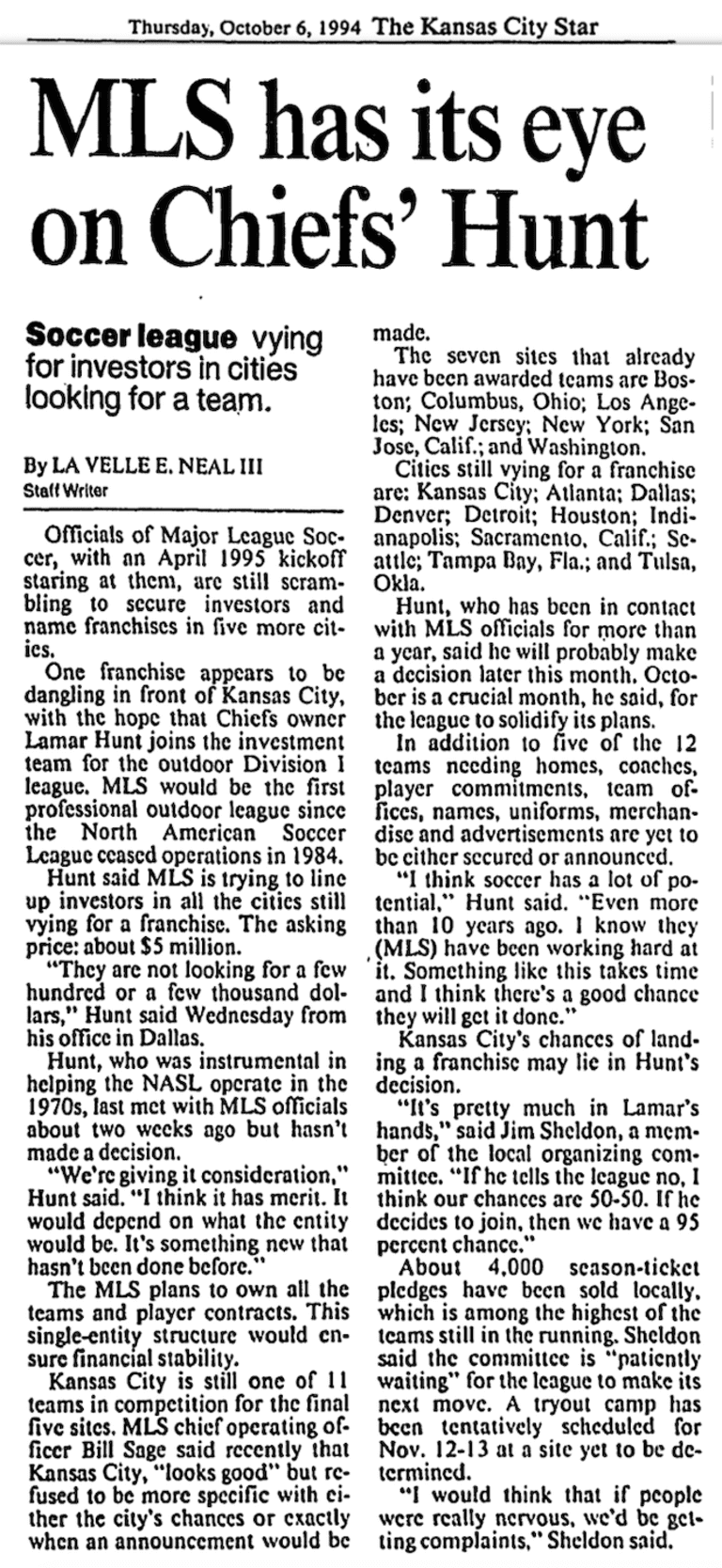
MLS introduced four groups of investors, including the Hunt family
Notably, Lamar Hunt was the only one of the four investors not aligned with a team.
The owner of the Kansas City Chiefs, Hunt had become committed to growing soccer in America after watching a broadcast of the 1966 World Cup final. He was a former chairman of the North American Soccer League and he owned the NASL’s Dallas Tornado in his hometown from 1967-1981.

“We’ve given him a list of cities we’d be happy with and if he picks any of those, that will be fine with us,” Rothenberg said.
MLS officials had been in discussions with Hunt for more than two years.
"We're giving it consideration," Hunt told The Star back in October 1994.
"It's pretty much in Lamar's hands," Sheldon said at the same time. "If he tells the league no, I think our chances are 50-50. If he decides to join, then we have a 95 percent chance."
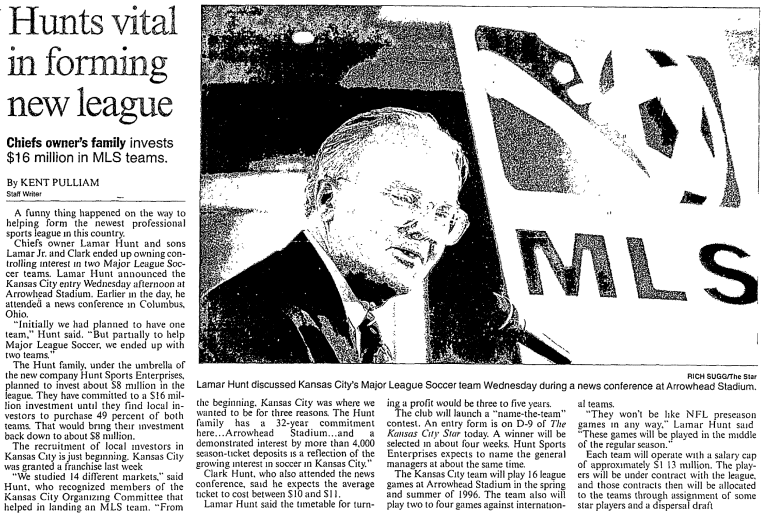
April 19, 1995
To summarize, Major League Soccer had confirmed eight teams for its inaugural 1996 season at this point with at least two more cities still to be added.
Kansas City was among the hopefuls and on April 19, 1995 there was a news conference at Arrowhead Stadium with Hunt…
And Chiefs quarterback Joe Montana, who had retired from football the day before.
The press conference though generated more than just comments on Montana’s legendary NFL career. It led to a scoop for Kansas City Star sports reporter Randy Covitz.
Covitz, who had started writing for the paper in 1981 by covering the debut of the Kansas City Comets, interviewed Hunt and asked about his involvement with MLS.
Hunt revealed he would be an investor in Kansas City, as well as Columbus.
"All things being equal, I think Kansas City and Columbus are going to be in," Hunt said. "We're having a number of meetings over the next couple of weeks that are going to decide the fate of that, but that's the route we're going now."

Hunt would later tell The Star, “Initially we had planned to have one team. But partially to help Major League Soccer, we ended up with two teams.
“We studied 14 different markets. From the beginning, Kansas City was where we wanted to be.”
June 6, 1995

With Hunt’s backing, Kansas City’s bid was nearly to the finish line and on June 6, 1995 – exactly 500 days after the MLS Bidders Conference began the marathon – Major League Soccer held a press conference in New York.
This time, Kansas City was officially joining Major League Soccer.
So too were Denver and Dallas, the latter of which replaced Chicago.
The 10 clubs would be divided into two conferences with the trio of newcomers all placed in the West along with Los Angeles and San Jose.
Each franchise would play a 32-game regular season with the top four finishers in each conference qualifying for the playoffs, structured as best-of-three quarterfinal and semifinal series to culminate with MLS Cup on Oct. 20, 1996.
Each team’s 18-player roster would have a salary cap (later set at $1.135 million with player salaries ranging from $24,000-$175,000 before bonuses/incentives) and could include up to four international players.
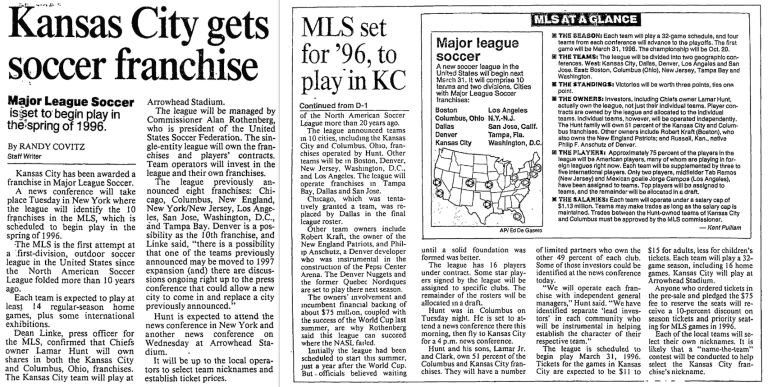
Those details were less important in the moment.
Finally and officially, Kansas City had a Major League Soccer team.
Now the team needed a name, a logo, a jersey, a general manager, a coach, a roster. Those elements emerge next in our 25th season retrospective as SportingKC.com reflects on 25 moments that set the stage for Kansas City's MLS debut on April 13, 1996.

